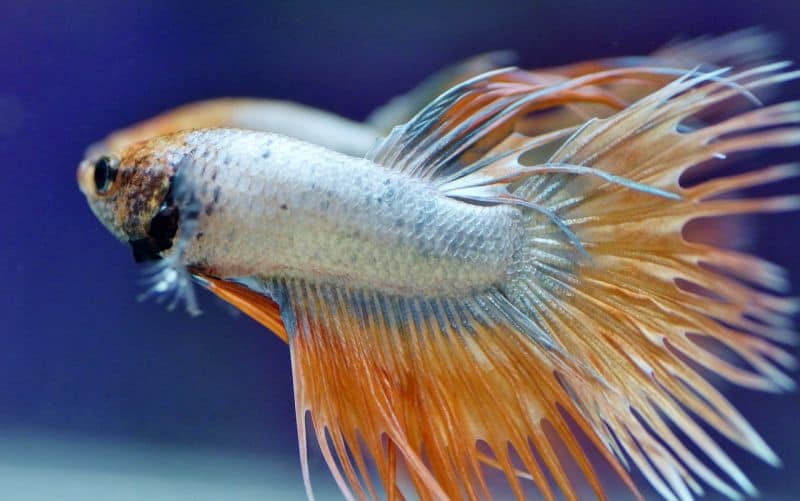Last Updated on November 29, 2020
We must know the gender of our Betta fish. This will prevent problems when setting up a community tank where you shouldn’t put a male betta and a female betta together. Breeding betta fish also requires that you pick male betta fish and a female betta fish as a breeding pair.
This species expresses sexual dimorphism which means male and female characteristics are distinct. This will help you determine the gender of Bettas.
In this article, you will learn how to know if betta fish is male and female by discussing:
- The characteristics of each
- Other questions related to knowing the gender of betta fishes
- And more!
Table of Contents
Coloration
Females have muted colors, but they can sometimes be colorful too. The males will have a more vibrant and rich color overall. Often males are more vividly colored than females. However, color alone is not a definitive predictor of gender.
A sick betta will display muted colors, so be sure your fish isn’t sick. Check for signs of illness such as lethargy, gray or white patches, and no appetite. Check all your water parameters and inspect the fish for signs of disease.
Your ammonia and nitrites should be at 0 ppm. Your nitrates should not exceed 20 ppm. Your water temperature should be between 78 to 82 degrees Fahrenheit. If you account all these things, you can rule out sickness.
Female bettas are still beautiful and can be vibrant, especially the blue and red varieties, but they will be less vibrant than their male counterparts. There are always exceptions. Breeders have successfully produced strains where both male and female have vivid colors.
The major exceptions are koi plakat bettas. The females can be just as vibrant as the males and have shorter fin lengths. The best way to determine the gender is by looking closely at the fin length.
Cellophane bettas can also look similar. They are light colored with occasionally clear fins. Most cellophane bettas are of the long-finned varieties, which makes it easy to tell the sexes apart.
Body Shapes
This is a good place to start when you want to determine a betta’s sex. Once you familiarize yourself with their different body shapes, you’ll be able to tell better the difference between a male betta and a female betta.
Females are slightly shorter, smaller, and more wide-bodied than male bettas. Males have more elongated bodies that are slightly flatter, side-to-side.
Females are recognizable because when they mature they are plumper looking compared to their slender male counterparts. The best place to spot the thickness of the female versus the male is looking at a betta head on facing you; females look oval, whereas males almost look triangular, with the point of the triangle at the top of their body.
Male bettas end up growing slightly larger than the female bettas, sometimes by as much as an inch. You can easily observe the size difference in the long-finned varieties. The long fins plus body length could make the males two or more inches larger than the females. The males need to be larger and have larger fins so they look bigger when flaring.
Fins

You can look at fin length and shape as a guide to know the gender of a Betta in domestic strains with short fins such as the plakat. The male has thicker and longer pelvic fins while the female betta’s equivalent fins are thin and short. In addition, the male’s anal fin extends while the female’s is short and neat.
Male bettas generally have longer fins as much as three or four times the length of the female’s. Plakat bettas have males with short caudal fins (tail). In most variants the females show shorter caudal fins compared to the males. The ventral fins of the male are noticeably longer and thicker than those of the female.
Observing the ventral fins is often the easiest way to differentiate male from female. Ventral fins are the two little fins that hang down from the body and are almost underneath the gills. A male’s ventral fins will be significantly longer than that of a female’s.
To recap, male betta fish have longer fins. The fins of a female also stay closer to the body while the male’s flare out away from the body.
Beard
Males bettas have a “beard” and we can see it when they flare their gills. The beard is a membrane hiding behind the gill plates or the gill coverings called the opercular membrane.
On a male betta, this black membrane will not entirely fit behind the gill plates and will stick out around the edges. Female bettas do not have a frilly “beard” extension to their gills. It is much smaller and not visible when the female isn’t flaring. If the female flares and forces her gill plates to the sides, you can see the beard, but it is not as impressive as a male’s beard.
The purpose of the beard is to make the betta look bigger when it flares. The entire display of flaring out the fins, gill plates, and beard, makes the betta look bigger and more impressive. We see this display during both spawning and territorial aggression.
Related: Different Types Of Betta Fish Based On Physical Features
Ovipositor
Mature female bettas have an ovipositor. It uses the ovipositor to lay eggs. To find your betta’s ovipositor, look at her underside. You’ll see a small white spot between the anal and ventral fins.
This is the easiest way to tell whether a betta fish is male or female. The female betta’s ovipositor is always visible once they are sexually mature.
Males rarely show an egg spot. With males that do show an egg spot, it is a false ovipositor. Some lose them as they get older and others just always have them. Young males have them.
Flaring
Male and female bettas flare. The male’s gill flaring is more impressive because of a “beard” it has behind its gill plates. This flares out beyond the gill plates causing the fish to look extra intimidating.
The females will also spread open their gill plates as a display of strength. Females may also assume a head-down posture when flaring which is a posture that males do not exhibit.
Bubble Nests
Generally, only the male builds a bubble nest. This is a floating nest made by trapping air in saliva, creating lots of bubbles. Healthy male Betta fish will make bubble nests when they are ready to breed. This bubble nest serves as a protective laver where the eggs attach to it until they hatch into fry.
Some betta enthusiasts have noted that occasionally a female will blow a bubble nest. However, those instances are rare.
Aggression
The males are the more territorial in which aggression and coloration breed them for years. You shouldn’t put two male betta fish in one tank. They have earned the name Siamese Fighting Fish for a good reason. Males are very territorial and will also attack females. They should only be in the tank together for a short time for breeding purposes.
Female bettas aren’t as fierce but they can still be aggressive toward other females and to other fish which aren’t compatible. This happens especially if there are only two females and one bullies the other.
For this reason, if you are keeping more than one female, keep at least five females in a sorority tank. So that aggressive behavior is more diffused and not directed toward the same individual.
Frequently Asked Questions
What causes male betta fish to attack each other?
Male betta fish fight each other because they are territorial. In their natural habitat, bettas have miles of rivers and paddies to swim through when the water levels are adequate. When one male enters another’s territory, the two may show aggression, but a fight may not happen because the inferior betta will surely have an escape route.
Why do male betta fish fight female betta fish?
Male and female betta fish will fight with each other too because of territorial instincts. They should only be together for a short while for breeding then separated again. It’s common for females to eat the eggs during spawning so a male will chase off and defend against this behavior.
Will baby betta fish fight each other?
Generally at about 8-9 weeks after hatching the fry will start to show their colors. At this age the males may start to assert their territorial personalities. This is the time you must separate them into their own tanks or containers.
How often do betta fish build nests?
Bubble nest building comes instinctively to a male betta fish especially when water conditions are optimal and the fish is thriving. If you do see a nest in the male betta fish’s tank then it is a very good sign that your betta fish is happy and healthy.
Do female betta fish always have eggs?
A mature female will not always have eggs. They should go through a conditioning phase where they must feast on good quality food to allow them to produce eggs. Feeding live food such as bloodworms and baby brine shrimp is arguably the best food that you can give to female betta fish in order to make them produce eggs.
How long will it take for female betta fish to be ready for breeding again?
They can be ready to breed after 12 – 14 days after spawning if they didn’t incur any injury. They must have at least a month’s rest if they suffered a rough mating process. The female cycle of egg production is 10 days.
